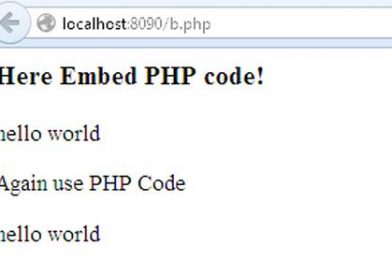I’ll teach you how to use PHP code in your HTML pages in this post. It’s for PHP newbies who want to improve their command of the world’s most popular server-side programming language.
PHP is a programming language that runs on the server. That is, a PHP script is run on the server, the output is created on the server, and the result is delivered to the client browser as HTML to render. It’s natural to integrate PHP and HTML in a script, but as a newbie, it might be difficult to figure out how to do so.
Ways to Combine PHP and HTML
When it comes to using PHP with HTML, there are two ways to take. The first is to embed the PHP code in the.html extension of your HTML file—this necessitates some particular considerations, which we’ll go over shortly. The alternative approach, and the recommended method, is to use .php files to mix PHP and HTML elements.
PHP is a server-side scripting language, which means that the code is interpreted and executed on the server. If you put the following code in your index.html file, for example, it won’t work right away.
First and foremost, don’t worry if you’ve never seen combined PHP and HTML code before; we’ll go over it in depth later in this post. In your browser, the following is displayed as a result of the preceding example:
<?php echo "Hello World" ?>As you can see, PHP tags in your.html page are not identified by default, and they are displayed as plain text without processing. Because the server is generally set up to only run PHP for files with the .php suffix, this is the case.
You may instruct the server to run your.html files as PHP files if you wish to run your HTML files as PHP, but it’s much preferable to place your mixed PHP and HTML code inside a .php file.
How to Add PHP Tags in Your HTML Page
When integrating PHP code with HTML text, you must use the PHP start tag <?php and the PHP end tag?> to encapsulate the PHP code. The PHP code enclosed between these two tags will be performed on the server before the requested file is given to the client browser.
Let’s have a look at a very simple example that uses PHP code to show a message. Create an index.php file in your document root with the following contents.
Output:-

As you can see, PHP code is parsed and performed on the server before being combined with HTML and delivered to the client browser.
Consider the following scenario:
This will display the current date and time, allowing you to create dynamic output from the server by inserting PHP code between the HTML tags. It’s crucial to note that any code between <?php and ?> the tags will be treated as PHP and the output will be interspersed with HTML tags once the page is performed on the server.
How to Use PHP Loops in Your HTML Page
One of the most typical jobs you’ll encounter while creating PHP scripts is iterating through arrays to generate HTML output. We’ll look at how to iterate through an array of objects and create output in this section.
In most situations, you’ll need to show material from an array that you’ve filled from a database or another source. For the sake of clarity, we’ll initialize the array with various values at the start of the script in this example.
To begin, we’ve set up the array at the start of our script. The foreach technique was then used to loop over the array values. Finally, the array element value was shown using the echo construct.
Output:-

The same example with a while loop looks like this:
And the result will be identical. So that’s how foreach and while loops may be used to produce HTML content from PHP arrays.
How to Use PHP Short Tags
We’ve used the <?php beginning tag as a starting tag in all of the examples thus far. In reality, PHP has a variant,<?=, that you may use as a short-hand syntax to show a text or the value of a variable.
By using the shorthand syntax, we may display a value without using the echo or print construct. When using echo or print to display something, the shorthand syntax is quick and easy to understand.
Including Code from Different Files
There are many instances where the same code must be used on many pages of a website. The header and footer sections of a webpage are an illustration of this. The HTML in these sections is usually the same as it is throughout the website.
Consider it as putting a website’s common CSS rules into a stylesheet rather than into the style tags on each pages.
In PHP, there are four functions that may be used to include additional files within a PHP file. include(), include once(), require(), and require once() are the four functions ().
The include() function will include and evaluate the provided file, and if it cannot find the file, it will issue a warning. The need() method accomplishes the same thing, but instead of a warning, it returns an error if the file isn’t found.
You may accidentally include the same file several times while working on large projects. This might result in issues such as function redefinition. Using PHP’s include once() and require once() methods is one approach to prevent these problems.
To demonstrate how to use these functions, we’ll use code from a prior section. In this example, I’ll use include(). Make a file named header.php and paste the code below into it.
Output:-

Create another file called date.php and place the following code in it.
Create one more file called day.php and place the following code in it.
Output:-

